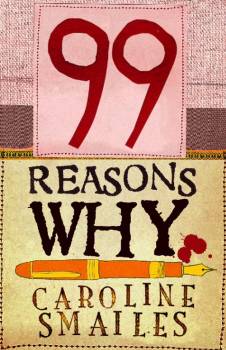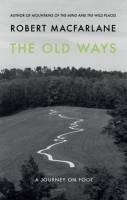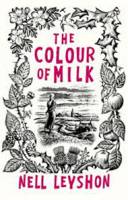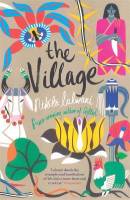Today, The Friday Project publish Caroline Smailes‘s latest book, 99 Reasons Why. It’s an ebook (available for Kindle and iPhone/iPad/iPod touch) with eleven possible endings: nine are available within the book itself; one is being handwritten by the author and auctioned for charity; and the other is being published on various blogs — including this one. You can find it below.
Month: March 2012
Garry Kilworth, ‘Let’s Go to Golgotha!’ (1975)
This piece – Kilworth’s first published story – deals with one of theoretical questions about time travel: if it were possible, wouldn’t there be time tourists? Simon and his family join a tour travelling back to witness the crucifixion of Jesus; they’ll be fine as long as they follow instructions to blend in. There’s a neat twist, which adds a layer of irony to the tale, as well as suggesting plausibly what might happen to time tourists; but I don’t think the story builds up quite enough to give the ending sufficient impact.
Rating: ***½
This is one of a series of posts on the anthology Not the Only Planet.
John Varley, ‘In the Bowl’ (1975)
In a human-colonised solar system, Kiku travels from Mars to Venus in the hope of finding blast jewels – naturally-occurring objects which can be caused to explode, leaving gems behind as debris. His guide is Ember, a young Jill-of-all-trades with a pet otter. I enjoyed this: there’s a drily humorous note to the narration; the precocious Ember is an engaging character; and the closing twist is nicely dark.
Rating: ***½
This is one of a series of posts on the anthology Not the Only Planet.
Frances Hardinge, Twilight Robbery (2011)

I keep hearing Frances Hardinge’s name mentioned as a YA fantasy writer whose work is of interest to adult readers; here’s my chance to judge for myself. Twilight Robbery is the standalone sequel to Hardinge’s debut, Fly By Night; it’s the continued adventures of an orphan girl named Mosca Mye, and her companions, Eponymous Clent (a thief and con artist) and Saracen (a goose whose default temperament is that of the Unseen University Librarian when the latter gets called a monkey). Travelling to the walled town of Toll, the three get caught up in a plot to abduct the mayor’s daughter. But Toll is no ordinary town: inhabitants and citizens alike are classified into ‘day’ and ‘night’ according to the folk deity under whose auspices they were born, and are only allowed to ‘exist’ during the relevant period (the town is even built so that its layout can change from day to night) – and, as story-luck would have it, Mosca and Clent fall on opposite sides of that divide.
For a start, Twilight Robbery is great fun to read: an intriguing plot with considerable momentum (even the many references to past events only make me want to read Fly By Night, rather than leaving me frustrated that I haven’t); and some lovely, rhythmic writing – like this, when Mosca is escaping from capture:
It takes time to find a lantern in the dark, long enough for two quick legs to sprint away into the heaving labyrinth of gorse. It takes time too for sleep-fumbled hands to strike tinder and nursemaid the trembling flame to the wick, long enough for small, cunning hands to snap off a fern-fan the right size to shield a black-haired head from sight. (p. 35)
Mosca Mye is a very appealing character. She’s exceptional in many ways – able to read in a world where many people of her social standing are not; just about the only person in Toll who isn’t charmed by the mayor’s daughter; able to move faster and squeeze into smaller spaces than lumbering adults – and thus a character whom change will follow; this, together with Mosca’s wit and the friction between her and Clent, make her a very engaging figure to read about.
Alongside all its brio, however, there’s a serious heart to Twilight Robbery; Hardinge does not shy away from the harshnesses of life, as shown when Mosca comes across a dead body in a wine cellar:
Mosca stood on the threshold and quivered. She hoped the cask had split. She hoped the darkened pool around the cask was wine. It smelt like wine. She wondered if she would ever be able to bear the smell of wine again. (p. 264)
Perhaps the central issue embodied in Twilight Robbery is that of social segregation; and, of course, Hardinge’s fantasy structure enables her to literalise that concept to an extraordinary degree. My main quibble with the novel has to do with how she handles this. Towards the end, Mosca is frustrated that she can’t do more to help; Clent replies that she has much to learn:
‘Bold actions have consequences, child…To be young is to be powerless, but to have delusions of power. To believe that one can really change things, make the world better and simpler in good and simple ways. To grow old is to realize that nobody is ever good, nothing is ever simple. That truth is cruel at first, but finally comforting.’
‘But…’ Mosca broke in, then halted. Clent was right, she knew that he was. And yet her bones screamed that he was also wrong, utterly wrong. ‘But sometimes things are simple. Just now and then. Just like now and then people are good.’ (pp. 454-5)
I find myself somewhat in sympathy with Clent’s view, here – not that people are never good, but that big issues tend not to have simple solutions. But the world of Twilight Robbery is a larger-than-life one where problems are responsive to bold actions, and a young girl like Mosca Mye can be an agent of change. I suppose this is partly in the nature of children’s literature; but the ending does feel like a disappointing flinch from a book which has not been afraid to be ‘grown up’ when it needed to be.
On balance, though, Twilight Robbery is a book I’m glad to have read, and Frances Hardinge an author I will be reading again in times to come.
Elsewhere
Frances Hardinge’s website
Martin Lewis reviews Twilight Robbery for Strange Horizons
Stephen Dedman, ‘Tourist Trade’ (1996)
Alan, our narrator, is very keen to help a woman who has arrived on Earth as a tourist, despite the fact that she appears quite capable of taking care of herself (she’s had her mind copied into a combat android for the trip); he’s keen because the tourist trade is all that Earth has left. In a few pages, Dedman sketches in the elaborate details of a future Earth controlled by aliens. But the resolution depends almost entirely on those details, and I find there isn’t time to digest them in order to then feel the emotional impact of the ending.
Rating: **½
This is one of a series of posts on the anthology Not the Only Planet.
Gene Wolfe, ‘Seven American Nights’ (1978)
I’ve enjoyed Gene Wolfe’s novels in the past, but always seem to end up disappointed by his short fiction. ‘Seven American Nights’ is a novella in which one Nadan Jaffarzadeh travels to anAmericawhose civilisation collapsed as a result of genetic damage; whilst there, he becomes infatuated with an actress he sees on stage.
I don’t find the story of Nadan’s journey engaging; don’t feel the sense of uncertainty that I’d expect from a subplot concerning whether or not he has ingested a hallucinogen; and the twist ending and odd moments of disjunction between Wolfe’s ruinedAmericaand the one we know are not enough to carry the story. Not one for me.
Rating: **½
This is one of a series of posts on the anthology Not the Only Planet.
Joe Abercrombie, The Heroes (2011)

It begins like this:
‘Too old for this shit,’ muttered Craw, wincing at the pain in his dodgy knee with every other step. (p. 9)
As a way of introducing a fantasy adventure novel, this sentence is very efficient: it establishes the narrative tone; it suggests that the characters we’ll follow will not necessarily be in peak physical condition (as is the stereotype); and it highlights that we are going to feel every twinge and scar.
The Heroes chronicles a three-day battle between the forces of the Union and the Northmen (it follows on from Joe Abercrombie’s earlier novels, but I never felt disadvantaged for not having read them); the title refers to a stone circle of strategic importance, but the nature of heroism is also a central concern of the book. It soon becomes clear that there aren’t many obviously ‘heroic’ characters in the cast: Abercrombie’s principal viewpoint characters are Calder, son of a former King of the Northmen, who fights on that side but is a coward only out for his own gain; Bremer dan Gorst, the bloodthirsty royal observer of the war for the Union, who tried out mercy but found it lacking; and Curnden Craw, that old warrior fighting for the Northmen, who believes in standing by his crew and doing the right thing – not that that’s always easy to determine. About the only character who comes close to the typical fantasy ‘hero’ is Whirrun of Bligh, who wields a legendary sword, knows from his goddess the moment and manner of his death, is widely considered mad – and is pretty comprehensively shown over the course of the novel to be misguided. So much for the hero.
The milieu Abercrombie depicts is largely masculine, but there are a few female characters. Of the three main ones, Wonderful, Craw’s second-in-command, and Ishri, the Northmen’s sorceress, never really rise above stereotypes (respectively, the female who’s as much one of the lads as the lads are, and the mysterious exotic); but Finree dan Brock (daughter of the Union forces’ commander-in-chief) is more rounded. She begins as a stereotype herself – the scheming wife of a powerful man (a colonel) – but then Finree comes up against the reality of war, and is changed in a complex way; she doesn’t lose her essential character, but rather the balance of her personality shifts in response to her experiences. Finree becomes more real because she cannot remain a stereotype after all that happens.
The bloody nature of war is emphasised throughout The Heroes, as is the relationship between war and heroism. Whirrun of Bligh might be enthusiastic for the benefits of war (‘This is the thing about war. Forces men to do new things with what they have. Forces them to think new ways. No war, no progress,’ p. 204); but most of the rest of the novel is not, and the possibility of true heroism also seems elusive. ‘A war is no place for heroics,’ (p. 34) comments one character; or consider the following passage, concerning the aftermath of an attack:
Gorst watched the whirling clouds of gnats that haunted the bank, and the corpses floated past beneath them. The bravery. Turning with the current. The honour. Face up and face down. The dedication of the soldiers. One sodden Union hero wallowed to a halt in some rushes, bobbing for a moment on his side. A Northman drifted up, bumped gently into him and carried him from the bank… (p. 222)
There’s some effective juxtaposition of ideal and reality, with an added reminder that those who fall in battle end up the same way, regardless of whose side they are on. Abercrombie’s conflict is one where a man may lose his life to a single arrow that he doesn’t see coming, or even by stepping off the path through a bog. ‘Death is a bored clerk, with too many orders to fill [thinks Gorst]. There is no reckoning. No profound moment. It creeps up on us from behind, and snatches us away while we shit.’ (p. 415)
The novel’s view of death and battle is also reflected in its narrative techniques. There’s a very effective chapter in which the viewpoint character of one scene is killed by the viewpoint character of the next. Abercrombie’s battle scenes are vivid, but also bring home the confusion and limited perspective of those involved. There’s also a nice seam of black humour running through the book. But the price of the jokes and the vigorous fight scenes is the suffering which follows, and The Heroes counts the cost of that suffering.
It crossed my mind whilst reading The Heroes just what a broad church fantasy is. We often define ‘fantasy’ by content (quests and magic and battles in an invented world, say), but we can also talk about it terms of affect – that is, stories which create a heightened sense of fantasy, of strangeness. The Heroes is interesting from that latter perspective because it works by stripping away any sense of fantasy – even the few interventions by the novel’s wizard characters are not so much ‘magic’ but artillery. The Heroes is a fantasy of cold, hard reality.
Elsewhere
Joe Abercrombie’s website
Video: Abercrombie reads an extract and is interviewed by his publisher
Some other reviews of The Heroes: Niall Alexander for Strange Horizons; Martin Lewis at Everything Is Nice.
Brian W. Aldiss, ‘The Difficulties Involved in Photographing Nix Olympica’ (1986)
Sergeants Ozzy Brooksand Al Shapiro take a week’s leave to travel across Mars from their base, to fulfil Brooks’s ambition of photographing Olympus Mons. The trip brings out the pair’s different characters, with Brook’s romanticism (when they spend the night on the floor of a giant ravine, he says: ‘wouldn’t this spot make a dramatic tomb?’) contrasted against Shapiro’s more practical nature.
I’m not sure what to make of this story: despite the closing twist of the protagonists’ fates, I can’t shake the feeling that there’s little else to the piece besides that contrast in personalities. I may be missing something; I hope I am.
Rating: ***
This is one of a series of posts on the anthology Not the Only Planet.
A dozen Penguin authors
On Thursday night, the good folks of Penguin General (the Fig Tree, Hamish Hamilton, and Viking imprints) hosted their second annual bloggers’ night, in the 5th View cocktail bar at Waterstones Piccadilly. This event was on a different scale from last year’s, with almost twice as many authors, and quite a few more bloggers – I don’t know if this was the largest-ever gathering of UK book bloggers, but I imagine it must have been close.
I was particularly pleased to get the chance to meet Nat Segnit, whose Pub Walks in Underhill Country was one of my favourite books from last year; he also gave one of the best readings of the night. But all twelve readings were good; so let’s go through them.
***
Naomi Alderman’s new novel is so new that there aren’t any advance copies yet, so she read from her laptop. The Liars’ Gospel is a retelling of the life and death of Jesus; Alderman read from the very beginning, which describes the ritual sacrifice of a lamb – and, if the rest of the book is as well-written as that, it’s one I want to read.

I already had a copy of Jennifer McVeigh’s debut, The Fever Tree, on the TBR pile. It’s set in South Africa in 1880, amid rumours of a smallpox epidemic in the diamond mines. There was some really good use of detail in the domestic scene which McVeigh read, and that bodes well for the rest of the novel.

Have I still never read anything by Marina Lewycka since A Short History of Tractors in Ukranian? (Answer: no, I haven’t.) I should probably rectify that, and Lewycka’s reading from Various Pets Alive and Dead was a good reminder of why. Her extract effectively sketched the four main characters in the novel, and included some sharp description of place.

Next up was Greg Baxter, whose first novel, The Apartment, was the second book from tonight already on my TBR pile. Baxter was a measured, precise reader, which went well with the spare style of his extract. I’m now still further intrigued to read the whole book.

22 Britannia Road by Amanda Hodgkinson tells of a Polish family reuniting in England after the war. I’m not quite sure whether this is a book for me, but I found the particular extract Hodgkinson read to be a good character sketch.
Now on to the only non-fiction book and author of the evening. The Old Ways by Robert Macfarlane is about the ancient paths ofBritain, the stories intertwined in them, and how people have been shaped by them. Macfarlane read an extract concerning an the encounter with Hanging figure by the sculptor Steve Dilworth; fascinating stuff, and definitely a book I’d like to read.

The second half of the evening began with Elif Shafak’s reading from her latest novel, Honour, which focuses on a Kurdish-Turkish family who move toLondon. Shafak read from the beginning of the book, where the daughter of the family prepares to meet her brother on his release from prison (he was convicted for murder). This was a strong set-up for the rest of the novel, and I look forward to reading on.
Set in 19th-centurySomerset, Nell Leyshon’s The Colour of Milk is the account of a girl named Mary, who is sent to work for the local vicar’s wife, where she has good reason to write down what happened to her. Leyshon’s excerpt gave a hint as to what that reason might be, and her reading brought Mary’s character vividly to life.

Then it was Nat Segnit’s turn to read from Pub Walks in Underhill Country – and it was just like discovering the book all over again. Segnit was an excellent reader (an audiobook of this read by him would be wonderful), and the extract he chose hilarious. Seriously, if you have not read this novel, you should.

From a novel I already loved to one of which I’d never even heard. Tom Bullough’s Konstantin is a fictional account of the life of the Russian rocket scientist Konstantin Tsiolkovsky; it was tricky to judge from the reading what the book as a whole might be like, but I started reading it on the train home, and it’s shaping up to be interesting.
The next author to take the stage was Nikita Lalwani, reading from her second novel, The Village. The set-up sounded intriguing – a documentary-maker travels fromEnglandto make a film about an Indian village which is also an open prison – and Lalwani’s reading only confirmed that view.

The evening closed with a reading from a Booker-winning author – James Kelman. Mo said she was quirky is a novel chronicling a day in the life of a single mother; on the evidence of Kelman’s reading, it’s also a novel very concerned with voice – it felt like a novel to be read out loud. I look forward to reading and finding out if that impression is correct.
***
And then, as Joshua Ferris put it, we came to the end. My thanks to everyone involved for such an enjoyable evening.
Orange Prize longlist 2012
Congratulations to all writers who have been longlisted for this year’s Orange Prize for Fiction:
Island of Wings by Karin Altenberg (Quercus) – Swedish; 1st Novel
On the Floor by Aifric Campbell (Serpent’s Tail) – Irish; 3rd Novel
The Grief of Others by Leah Hager Cohen (The Clerkenwell Press) – American; 4th Novel
The Sealed Letter by Emma Donoghue (Picador) – Irish; 7th Novel
Half Blood Blues by Esi Edugyan (Serpent’s Tail) – Canadian; 2nd Novel
The Forgotten Waltz by Anne Enright (JonathanCape) – Irish; 5th Novel
The Flying Man by Roopa Farooki (Headline Review) – British; 5th Novel
Lord of Misrule by Jaimy Gordon (Quercus) – American; 4th Novel
Painter of Silence by Georgina Harding (Bloomsbury) – British; 3rd Novel
Gillespie and I by Jane Harris (Faber & Faber) – British; 2nd Novel
The Translation of the Bones by Francesca Kay (Weidenfeld & Nicolson) – British; 2nd Novel
The Blue Book by A.L. Kennedy (JonathanCape) – British; 6th Novel
The Night Circus by Erin Morgenstern (Harvill Secker) – American; 1st Novel
The Song of Achilles by Madeline Miller (Bloomsbury) – American; 1st Novel
Foreign Bodies by Cynthia Ozick (Atlantic Books) – American; 7th Novel
State of Wonder by Ann Patchett (Bloomsbury) – American; 6th Novel
There but for the by Ali Smith (Hamish Hamilton) – British; 5th Novel
The Pink Hotel by Anna Stothard (Alma Books) – British; 2nd Novel
Tides of War by Stella Tillyard (Chatto & Windus) – British; 1st Novel
The Submission by Amy Waldman (William Heinemann) – American; 1st Novel




Recent Comments